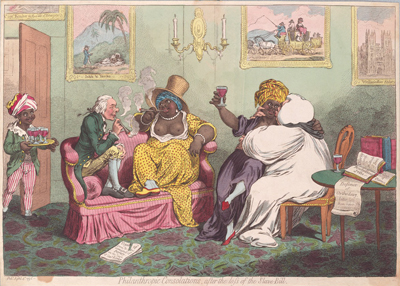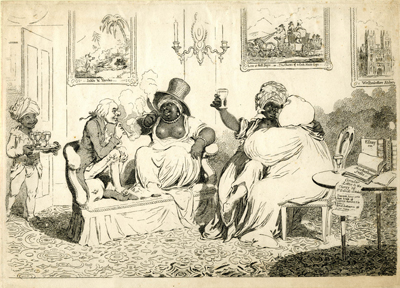Philanthropic Consolations
after the Loss of the Slave Bill
This is one of the more cynical and misleading of Gillray's prints. It purports to portray two of the leading opponents of the slave trade, William Wilberforce and Bishop Samuel Horseley, as utter hypocrites, exploiting some of the very people they were pledged to defend.

© Beinecke Rare Book and Manuscript Library, Yale University
The push for the abolition of slavery had been much discussed as early as 1787 when The Society for the Abolition of the Slave Trade was first formed by group of (mostly) Quakers. Although initially reluctant, William Wilberforce became the face of the movement in the House of Commons, introducing the first of many interations of the Bill Abolishing the Slave Trade in 1791. Horseley, the Bishop of Rochester, similarly became a prominent spokesman for the cause in the House of Lords. The bill, however, met with substantial resistance from wealthy plantation owners whose crops of tobacco and sugar cane depended upon slave labor and from merchants whose commerce in slaves was a highly profitable business. And on March 15, 1796, the bill was once again defeated.
Significantly, Philanthropic Consolations. . . contains only a publication date (April 4, 1796); there is no indication of publisher or designer. That leads me to suspect that this may have been a print commisioned and distributed by those interests which had an investment in maintaining the status quo. But in this case the aim was not to make anything as abstract as economic arguments for continuing the slave trade, but to launch personal attacks, undermining the moral legitimacy of Wilberforce and Horseley, and, by extension, that of other abolitionists.
As a design, the image space of the print is divided into two parts with the wall sconce serving to demarcate the boundary. On one side is Wilberforce; on the other is Horsely. The activities they are engaged in and the objects that surround them help to identify and satirize them. To begin with, there is the irony of Wiberforce smoking with a negress whose fellow blacks would have slaved in tobacco fields to provide those cheroots. Then there are the questionable motives of a man sitting opposite a bare-breasted negress while his companion is groping another black woman. According to Draper Hill, one of the alternative titles Gillray considered for this print was A Peep into ye motives for ye repeal of ye slave trade. In keeping with this line of thinking, above Wilberforce is a painting of Incle & Yarico, a popular story of interracial attraction which was made into a comic opera in 1787 and would have been familiar to Gillray's audience.
But perhaps the most damning and least obvious element of this part of the satire is the painting in the upper-left of the image labeled "Captn Kimber in the Cells of Newgate. John Kimber was the captain of the slave ship Recovery that picked up African natives from New Calabar and transported them to Grenada where they would be sold. In a speech before Parliament in 1792, Wilberforce had accused him of the torture and murder of a young black girl on board his ship. Kimber was subsequently imprisoned and tried at the Old Bailey in London, but acquitted when one of the witnesses was shown to have perjured himself in providing contradictory testimony. The paper at Wilberforce's feet refers to that perjury conviction. The combined references were obviously intended to discredit the otherwise overwhelming evidence presented by Wilberforce and his associates of the barbarities of the slave trade. In this context, the smoke thrown up by Wilberforce and his negress may be intended as an oblique suggestion of intentional and cooperative obfuscation.
The Horseley side of the print is simpler. Some of the details simply help to identify Horseley and distinguish him from the randy and hypocritical prelates that populate many a caricature by Rowlandson and others. For instance, there is a painting on the wall of "Westminster Abbey" where Horseley was Dean. There is a volume labeled Mathematick, referring to his commentaries on Newton's Mathematics. And a manuscript, the Defence of Orthodoxy which probably refers to his writings against dissenters, and an on-going dispute with one of those dissenters, Joseph Priestley, about Christ's divinity. But most of the other details suggest that Horseley is a hypocrite and philanderer, whose "Charity" according to the books on the table beside him, "covers a multitude of sins," for whom "Humanity" is a mask, and whose pretence of concern is but one of the Bishop of "Rochester's Jests."* In the painting directly above Horseley, a man in a coach looking very much like the bishop is gazing lecherously at the leg of a young woman riding above. In an earlier state of the print in the British Museum, the painting is titled: Love at first Sight, or the Charms of a Cook-Maids legs.

© Trustees of the British Museum
* Rochester's Jests was a real book whose full title was: Rochester's Jests, or the Quintessence of Wit: An Entire New Collection of Funny Jests, Droll Stories, Keen Repartees, Merry Jokes, Excellent Puns, Comical Bulls, Egregious Blunders and Quaint Conundrums.
Sources and Reading
- Commentary from the British Museum on Philanthropic Consolations after the Loss of the Slave Bill.
- Draper Hill, Fashionable Contrasts, 1966, #17.
- "William Wilberforce," Wikipedia
- "Samuel Horsley," Wikipedia
- "John Kimber," Wikipedia
- "Slave Trade Act 1807," Wikipedia
- The Abolition Project
- "Social Reform and Comic Opera: Inkle and Yarico" by Linda V. Troost from her book, The Rise of Comic Opera
- "Inkle and Yarico," Wikipedia
- Thomas Wright and Joseph Grego, The Works of James Gillray, the Caricaturist; With the History of His Life and Times
Comments & Corrections
NOTE: Comments and/or corrections are always appreciated. To make that easier, I have included a form below that you can use. I promise never to share any of the info provided without your express permission.